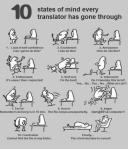Since my last post, I have been busy with many things. I started a copywriting course, for example. Making my way through the course material, I am constantly struck by how almost everything is just as relevant for translators as it is for copywriters. So I thought I’d share a few tips from the course material that seem to hit the nail on the head.
1. ”Keep saying to yourself: ‘there’s always another way to write this’”
This is the best advice of all, in my view. Any text we translate has (hopefully) been optimised for another language and culture, and as all languages have their own syntax and register, translations that follow the source text too closely are bound to fall flat on their face.
In other words: paraphrase or stock up on plasters.
2. “Keep it simple”
 If Bruce says so, it must be true. Simplify the language you are translating if it makes it easier to read/understand in your language – there is no need to follow the same sentence structure as the original. I tend to use this advice as a general guideline – whenever I’m stuck with a few different constructions and can’t make up my mind which one to use, I almost always settle for the most direct and the most simple. I don’t know if it is good advice for all language combinations, but it works for me.
If Bruce says so, it must be true. Simplify the language you are translating if it makes it easier to read/understand in your language – there is no need to follow the same sentence structure as the original. I tend to use this advice as a general guideline – whenever I’m stuck with a few different constructions and can’t make up my mind which one to use, I almost always settle for the most direct and the most simple. I don’t know if it is good advice for all language combinations, but it works for me.
3. “Take aim, you’re targeting your audience”
 Just like a copywriter is hired to rephrase and expand the instructions in the brief provided, a translator has to rethink the structure of the original text and try to express themselves in a language that sounds appealing for the target audience. We are not translating to please the original text, we are translating to please our readers.
Just like a copywriter is hired to rephrase and expand the instructions in the brief provided, a translator has to rethink the structure of the original text and try to express themselves in a language that sounds appealing for the target audience. We are not translating to please the original text, we are translating to please our readers.
The target audience for a translation is not necessarily the same as the target audience for the source text, and even if they share some characteristics (age, for example), there are always cultural differences to take into account.
4. “Achieve a consistent tone of voice – use a word bank”
This one should rather go under the heading “what copywriting can learn from translation”. Most translators, and perhaps especially those with experience from working in-house at large corporations and translation agencies, are only too familiar with the highs and lows of translation CAT tools and their translation memories and termbases.
Recently I looked around on Google to see if I could find any copywriting software, but I had no luck whatsoever – something like a monolingual Trados or Wordfast, a program I could use to save my work in projects per client, which would enable me to quickly access previous texts I have done for a particular company, search for terms I have used, store useful reference material and notes. I couldn’t find anything. Is there really nothing like this available? Anyone out there who knows? If so, I would be really interested to hear about it!
5. “It’s critical to have good material to work with, because although you’re being creative you are not making anything up. You can’t polish a turd.”
This one I don’t necessarily agree with. Or – I agree that copywriters are not hired to make stuff up, and of course it helps to have good material to work with – but in reality, it seems, good material is not something that can be taken for granted. And isn’t this exactly why companies hire copywriters (and designers, and translators) – because they need somebody who can make the mess look pretty.
6. “…leave your ego at the door – your work is not going to be hanging in the Louvre.”
 I have never met a translator who thinks that their work should be hanging in a museum. I have, however, met quite a few who seem unwilling to accept feedback or who take it as a personal attack. I’m not saying that it’s always easy or pleasant to receive feedback, but isn’t it really important to have a dialogue with the client to make sure that they are happy? It is their text, after all, not a timeless work of art.
I have never met a translator who thinks that their work should be hanging in a museum. I have, however, met quite a few who seem unwilling to accept feedback or who take it as a personal attack. I’m not saying that it’s always easy or pleasant to receive feedback, but isn’t it really important to have a dialogue with the client to make sure that they are happy? It is their text, after all, not a timeless work of art.
7. “Communicating is more important than the rules of grammar.”
I don’t think it’s necessary to be a linguist to be a good translator. It is more important to be a good writer in the language we’re translating into, and writers are not linguists by default.
A typo is not the end of the world, and it takes more than correct grammar to create an engaging text. Not everyone will agree, I’m sure. But I think Stephen Fry would and that’s enough.
8. Headlines need to “grab attention and provoke interest”
Creating headlines is tricky, because in order to grab attention and provoke interest, they have to stand out and at the same time be informative and SEO friendly and not too long. Creating translated headlines is even harder, because they have to do all that whilst not messing with the original headline too much – and this headline may be perfect for the original audience but not for the translation’s target audience.
9. ”Increasing numbers of copywriters are based in-house teamed with a desiger or creative artworker”
This is music to my ears, and I really hope it is a trend also with translations. It is never a good idea to produce text (be it copy or translation) in isolation, without taking the visual side into consideration. When copywriters and translators are involved in the publishing process, either by cooperating with a designer or at least by making sure that they know what the final product will look like, the result has a great chance of being just that. Great.
10. Attitude to the profession
Finally – I follow a few pages about translation and a few pages about copywriting on Facebook, and find it fascinating to compare the kind of things they share. Somehow, it seems to reveal something about their general attitude to the profession.
A few things that have been shared by copywriters… (click on the images to enlarge)
…and a few things shared by translators…
I think these images speak for themselves?
Reference:
The quotes are taken from the excellent course book Copywriting: Successful writing for design, advertising and marketing by Mark Shaw (highly recommended for students of copywriting and translators alike!) or from the course pack provided by the Blackford Centre for Copywriting.







